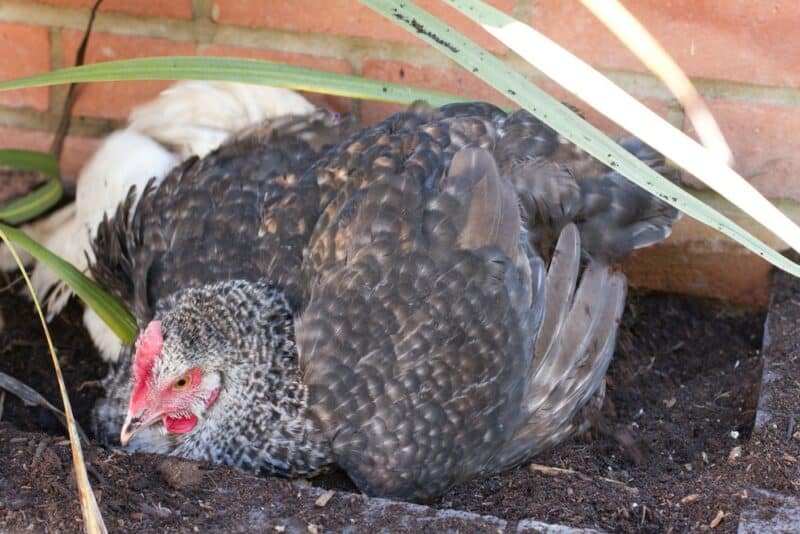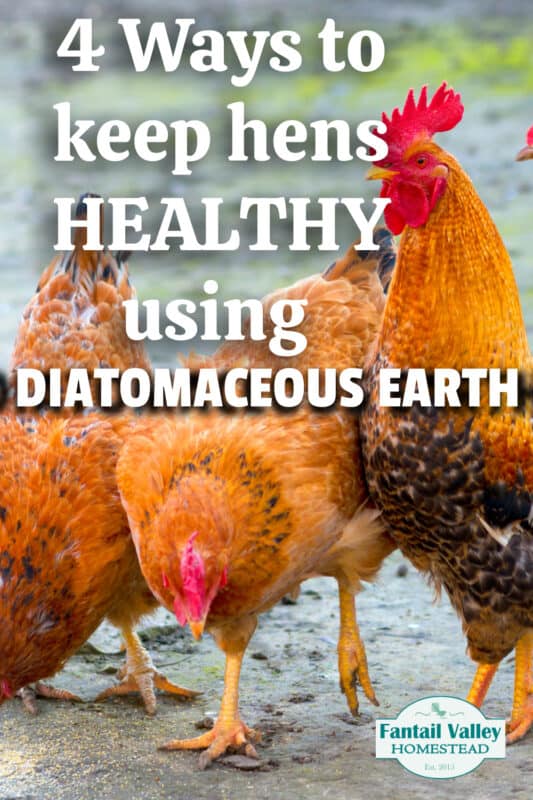This post was most recently updated on January 31st, 2023
Diatomaceous earth, also known as DE, is a natural and effective way to keep chickens healthy and happy. It is made from the fossilized remains of tiny aquatic organisms called diatoms, and has many beneficial uses for chickens.
Please read: This information is provided for educational purposes only and is not intended to treat, diagnose or prevent any disease. We encourage you to make your own health care decisions in partnership with a qualified health care professional.
This post contains affiliate links, this means at no extra cost to you, we make a commission from sales. Please read our Disclosure Statement
-
Dust Baths
One of the most common uses of DE for chickens is as a dust bath. Chickens love to take dust baths to keep their feathers clean and healthy, and DE is a great addition to their dust bath mixture.
When using diatomaceous earth (DE) for a dust bath for chickens, it’s recommended to use around 2-3 tablespoons of DE per square foot of dust bath area. This will provide enough DE to effectively control pests while also being safe for the chickens to use.
To create a dust bath, you can use a shallow container or a designated area in the coop or run. Fill it with a mixture of DE and other dry materials such as sand, dirt, or ashes. Chickens will naturally seek out and roll around in the dust bath to clean and preen their feathers, which will help control pests and keep their feathers healthy.
Other things to add to a dust bath
In addition to DE, there are other natural materials that can be added to the dust bath for pest control:
- Dried herbs such as rosemary, thyme, and oregano contain essential oils that can repel pests and also have antimicrobial properties.
- Food-grade neem powder is a natural pesticide that can be added to the dust bath to control mites, lice, and other parasites.
- Wood ashes can be added to the dust bath as they have a high pH which can help to repel pests and also help to remove oils and dirt from feathers.
- Sulfur powder can be used as a natural pesticide and also helps to dry out the skin of parasites, making it difficult for them to survive. When using sulfur powder in a dust bath for chickens, it’s recommended to use a small amount, around 1-2 tablespoons per square foot of dust bath area.This will provide enough sulfur to effectively control pests while also being safe for the chickens to use.
It’s important to note that sulfur powder can be quite potent and can cause respiratory issues if inhaled in large amounts. Therefore, it’s important to use it in moderation, and to make sure that the dust bath is not in an enclosed area where chickens will be spending a lot of time.
Also, it’s important to note that some chickens may have a sensitivity to sulfur, so it’s recommended to monitor the chickens for any signs of distress such as sneezing, coughing, or difficulty breathing. If you notice any of these symptoms, remove the sulfur powder from the dust bath immediately.
Be careful when handling sulfur powder, as it can cause irritation to the skin and eyes. Be sure to wear gloves and goggles when handling it, and wash your hands thoroughly after use.
In general, use all the dust bath ingredients in moderation and to make sure that the chickens are not consuming them in large quantity as it could lead to health issues if ingested. Remember to make sure the dust bath is cleaned and refilled regularly to maintain effectiveness.
Please note that all these materials should be used in moderation and to make sure that the chickens are not consuming them in large quantity as it could lead to health issues if ingested.
-
Treating Mites
DE is also effective at treating mites, which can be a common problem for chickens. Mites can cause chickens to lose feathers, become itchy and uncomfortable, and even lead to anemia if left untreated.
To use DE for mite treatment, simply sprinkle it on the chickens’ feathers and in their coop. An easy way to apply it to the chickens is to put it in a sport sock and tie off the end, then you can use it as a powder puff and dab it of between the chickens feathers.
The sharp edges of the DE particles will puncture the mites’ exoskeletons, causing them to dehydrate and die.
DE can also be mixed with water to make a spray and can be used to treat the coop and surrounding areas to prevent mites from re-infesting.
-
Internal Parasites
DE can also be used to control internal parasites in chickens. These parasites can cause a variety of health problems for chickens, including diarrhea, weight loss, and even death.
To use DE for internal parasite control, simply add it to their feed or water. The DE will work to dehydrate and eliminate any parasites that may be present in the chickens’ digestive systems. It is important to note that DE should be used as a preventative measure and not as a treatment for an already infected flock.
How to use DE to treat internal parasites in chickens
When using diatomaceous earth (DE) as a dietary supplement for chickens, the recommended amount to add to their food or water is about 1-2 tablespoons per 50 pounds of feed or the same amount in 10 gallons of water. This amount can vary depending on the quality and purity of the DE you are using, so it’s best to consult the manufacturer’s instructions for specific dosage recommendations.
It’s important to note that DE is a desiccant, which means it absorbs moisture. It is best to add DE to the feed or water just before serving it to the chickens, as prolonged exposure to DE can cause the feed or water to become less palatable.
When using DE as a dewormer, it’s recommended to add it to the feed for at least 7-14 days. It seems that DE works by absorbing the oils and fats from the worms, causing them to dehydrate and die.
It’s essential to use food-grade DE, as the other types of DE may contain crystalline silica, which can be harmful if ingested.
-
In the Coop
DE can also be used in the coop to keep it clean and free of parasites. Sprinkle DE on the floor and in the nesting boxes to absorb moisture and odors.
DE can also be used to control pests such as ants, roaches, and bed bugs. Simply sprinkle DE around the base of the coop and in any cracks or crevices where pests may be entering.
Dangers and downs sides to using Diatomaceous Earth with Chickens
While diatomaceous earth (DE) is generally considered safe for chickens and can provide many benefits, there are a few potential downsides to be aware of when using it.
One potential downside is that DE can be abrasive and may irritate the respiratory system of chickens if it is inhaled in large amounts. To avoid this, it is important to use food-grade DE and to avoid applying it in areas where chickens will be spending a lot of time, such as in their coop or in a closed area.
Another potential downside is that DE can be harmful to beneficial insects such as bees and ladybugs. If you are using DE to control pests in your chicken coop and you also have beneficial insects in the area, consider using a less abrasive method of pest control.
Additionally, DE doesn’t discriminate between beneficial and harmful insects so it’s important to make sure that the chickens are not consuming DE in large quantity as it could lead to health issues if ingested.
Finally, it’s worth mentioning that DE is not a registered pesticide, it’s not a complete solution for pest control and it’s not a replacement for proper coop sanitation and biosecurity practices.
Overall, DE can be a useful tool for controlling pests and improving the health of chickens when used correctly, but it’s important to use it carefully to avoid potential downsides.
Lime vs diatomaceous earth for chicken coops?
Both lime and diatomaceous earth (DE) can be used to benefit chickens and their coops, but they have different properties and uses.
AGRICULTURAL LIME
Lime, specifically hydrated lime, is a type of calcium carbonate that can be used to raise the pH level of the coop’s environment, making it less hospitable to pathogens and parasites.
Lime can also be used to dry out the coop and reduce odors. It is typically added to the coop’s bedding or mixed into the soil of the run.
Lime can be harmful if inhaled and care should be taken when handling it. It’s also important to note that it should not be used in the same area where the chickens will be feeding, as the high pH can cause digestive issues if ingested.
DIATOMACIOUS EARTH
DE, on the other hand, is a natural powder made from the fossilized remains of tiny aquatic organisms called diatoms. It is most commonly used as a natural pest control, as the sharp edges of the diatoms can cut through the exoskeletons of common chicken pests such as mites and lice, effectively killing them.
DE can also be used to prevent and treat external parasites such as mites and lice. It can also be used as a natural dewormer, and a way to improve overall chicken health and maintain a clean coop. DE can be added to the coop’s bedding or mixed into the chickens’ feed.
Lime can be used to raise the pH level of the coop and make it less hospitable to pathogens and parasites, while DE is a natural pest control, a parasite preventative and treatment, a natural dewormer, and a way to improve overall chicken health and maintain a clean coop. Both can be used in a chicken coop, but it’s important to use them correctly and to follow all the safety precautions to avoid any potential issues.
In conclusion, Diatomaceous earth is a versatile, natural and effective way to keep chickens healthy and happy. Whether you’re using it as a dust bath additive, treating mites, controlling internal parasites or keeping the coop clean, DE is a valuable tool for any chicken owner. Remember to use food grade DE and always consult a veterinarian before starting any treatment.


